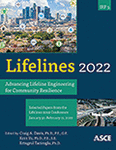Depth Completion from Sparse 3D Maps for Automated Defect Quantification
Publication: Lifelines 2022
ABSTRACT
For lifeline systems, routine visual inspections play a vital role in gathering structure-level data to inform asset maintenance strategies. Current research has shown that data repeatability and objectivity may be enhanced with computer vision and robotics, whereby manual collection, cataloguing, and quantification of defects is automated. For instance, low-cost lidar sensors integrated with a robotic platform can collect 3D geometric information of a structure via simultaneous localization and mapping (SLAM), with image data fusion allowing for defect measurement. While low-cost lidars provide a fast and inexpensive way of obtaining defect measurements, maps they produce often lack the density required for accurate quantification. To remedy this, we combine depth completion enhanced point cloud data from a lidar with labelled image data to extract a more complete surface estimate in physical scale. Given a 3D map, image data with known camera poses, and camera intrinsic calibrations, our approach first transforms the 3D map to a depth map (within camera frame) through ray casting. Depth maps are then densified using a depth completion algorithm that employs image processing techniques tailored to suit sparse lidar map data. Lastly, the combination of labeled defect images and dense depth maps is exploited to extract high-resolution area measurements for defects such as spalls and delaminations. The accuracy of our method has been assessed by comparing results to those obtained from non-depth completed data and to ground truth measurements obtained using a high-resolution monocular camera with manual scale input to each image. Using a data set containing six concrete area defects, our method was shown to reduce error, on average, by 14.2%, with depth completed results having an average area error of 5.3% from the ground truth. Our results show that depth completion on sparse 3D maps can be effective in fine-scale defect quantification, providing a more complete assessment of lifeline system condition using affordable sensors.
Get full access to this article
View all available purchase options and get full access to this chapter.
REFERENCES
Charron, N., McLaughlin, E., Phillips, S., Goorts, K., Narasimhan, S., and Waslander, S. L. (2019). “Automated bridge inspection using mobile ground robotics.” Journal of Structural Engineering, 145(11), 04019137.
Chen, L.-C., Papandreou, G., Schroff, F., and Adam, H. (2017). “Rethinking atrous convolution for semantic image segmentation.” arXiv preprint arXiv:1706.05587.
Everingham, M., Van Gool, L., Williams, C. K., Winn, J., and Zisserman, A. (2010). “The pascal visual object classes (voc) challenge.” International journal of computer vision, 88(2), 303–338.
Geiger, A., Lenz, P., Stiller, C., and Urtasun, R. (2013). “Vision meets robotics: The kitti dataset.” International Journal of Robotics Research (IJRR).
Jaritz, M., De Charette, R., Wirbel, E., Perrotton, X., and Nashashibi, F. (2018). “Sparse and dense data with cnns: Depth completion and semantic segmentation.” 2018 International Conference on 3D Vision (3DV), IEEE, 52–60.
Ku, J., Harakeh, A., and Waslander, S. L. (2018). “In defense of classical image processing: Fast depth completion on the cpu.” 2018 15th Conference on Computer and Robot Vision (CRV), IEEE, 16–22.
McLaughlin, E., Charron, N., and Narasimhan, S. (2020). “Automated defect quantification in concrete bridges using robotics and deep learning.” Journal of Computing in Civil Engineering, 34(5), 04020029.
Phillips, S., and Narasimhan, S. (2019). “Automating data collection for robotic bridge inspections.” Journal of Bridge Engineering, 24(8), 04019075.
Qiu, J., Cui, Z., Zhang, Y., Zhang, X., Liu, S., Zeng, B., and Pollefeys, M. (2019). “Deeplidar: Deep surface normal guided depth prediction for outdoor scene from sparse lidar data and single color image.” Proceedings of the IEEE Conference on Computer Vision and Pattern Recognition, 3313–3322.
Sandler, M., Howard, A., Zhu, M., Zhmoginov, A., and Chen, L.-C. (2018). “Mobilenetv2: Inverted residuals and linear bottlenecks.” Proceedings of the IEEE conference on computer vision and pattern recognition, 4510–4520.
Van Gansbeke, W., Neven, D., De Brabandere, B., and Van Gool, L. (2019). “Sparse and noisy lidar completion with rgb guidance and uncertainty.” 2019 16th International Conference on Machine Vision Applications (MVA), IEEE, 1–6.
Information & Authors
Information
Published In
History
Published online: Nov 16, 2022
Authors
Metrics & Citations
Metrics
Citations
Download citation
If you have the appropriate software installed, you can download article citation data to the citation manager of your choice. Simply select your manager software from the list below and click Download.
